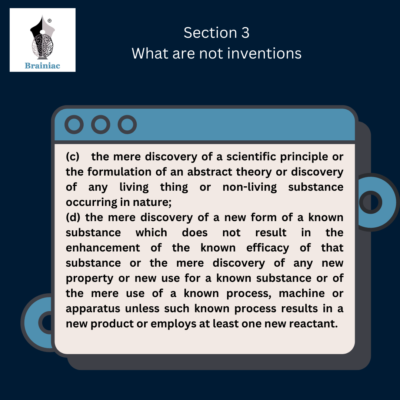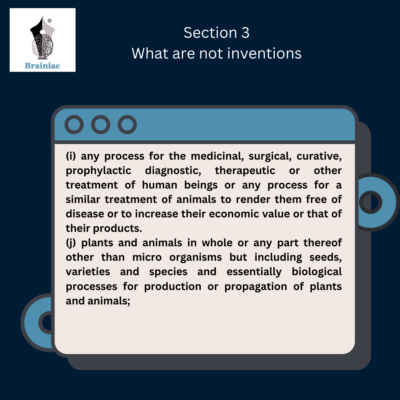The Patent Act, 1970 lays out legal framework that is intended to protect and encourage creativity and invention in India. Section 3 of the Act defines the parameters for what cannot be regarded a patentable invention. It outlines numerous categories of subject matter that are not eligible for patentability, ensuring that patents are only given for genuine inventions that meet specified criteria, and it excludes several categories of subject matter from patentability. In this post, we will examine every clause of Section 3, providing detailed explanations to help readers gain a better understanding of the Indian Patent Act and its provisions regarding what can and cannot be patented in the country.
- Clause (a) – Frivolous or in violation of Natural Law:
 This clause states that inventions that are frivolous or clearly contradict well-established natural rules are not patentable. This rule ensures that patents are not granted for inventions that do not represent significant technological progress or are based on pseudoscience. A perpetual motion machine, for example, that claims to generate infinite energy without any external input would fall into this category.
This clause states that inventions that are frivolous or clearly contradict well-established natural rules are not patentable. This rule ensures that patents are not granted for inventions that do not represent significant technological progress or are based on pseudoscience. A perpetual motion machine, for example, that claims to generate infinite energy without any external input would fall into this category.
- Clause (b) – Contrary to Public Order, Morality, or Environmental Well-being:
This provision forbids the patenting of inventions that, if commercialized, could be in violation of public order or morals or cause substantial harm to human, animal, or plant life, health, or the environment. An invention that facilitates the creation of extraordinarily hazardous poisons or weapons of mass devastation or a machine and a device prepared with the purpose of counterfeiting currency are some examples.
- Clause (c) – Mere Discovery of Scientific Principles or Natural Substances:
 Simple discoveries of scientific concepts or the development of abstract hypotheses are not patentable under this provision. Inventions involving the discovery of a live item or a non-living substance in nature are also prohibited. For example, under this rule, the discovery of a specific DNA sequence identified in a certain plant species would not be patentable.
Simple discoveries of scientific concepts or the development of abstract hypotheses are not patentable under this provision. Inventions involving the discovery of a live item or a non-living substance in nature are also prohibited. For example, under this rule, the discovery of a specific DNA sequence identified in a certain plant species would not be patentable.
- Clause (d) – New Form, New Property, or New Use of a Known Substance:
This provision specifies that the simple discovery of a novel version of a known chemical that does not improve its efficacy is not patentable. Similarly, unless it results in the synthesis of a new product or includes the use of a new reactant, the mere discovery of a new property or purpose for a known substance is eliminated. For example, if it is discovered that a known
- Clause (e) – Mere Aggregation or Admixture of Substances:
 A substance obtained by a simple mixing resulting in the aggregation of the qualities of its components, or a process for making such a material, is not patentable. In other words, a combination of existing substances cannot be patented if it does not result in a novel product with improved features or advantages. A blend of two known substances, for example, that does not demonstrate any novel or unexpected features would not be patentable.
A substance obtained by a simple mixing resulting in the aggregation of the qualities of its components, or a process for making such a material, is not patentable. In other words, a combination of existing substances cannot be patented if it does not result in a novel product with improved features or advantages. A blend of two known substances, for example, that does not demonstrate any novel or unexpected features would not be patentable.
- Clause (f) – Arrangement or Duplication of Known Devices:
This clause prohibits patents for inventions involving the mere arrangement or re-arrangement of existing devices, each of which functions independently in a recognized manner. The arrangement should have no synergistic benefits or enhancements that go beyond the individual devices. Rearranging the buttons on a TV remote control, for example, would not be patentable.
- Clause (g) – omitted
- Clause (h) – Agriculture or Horticulture Methods:
- Agriculture and horticulture methods are not considered patentable innovations under this clause. This exclusion is intended to prevent the patenting of traditional farming or gardening techniques, which are widely regarded as part of traditional knowledge and practises.
- Clause (i) – Medical Treatment Methods
 This provision forbids the patenting of procedures for the treatment of humans or animals in order to cure them of disease or raise their commercial value. Processes for medical, surgical, curative, prophylactic, diagnostic, therapeutic, or similar therapies are excluded. A specific surgical procedure to remove cataracts, for example, or a treatment method for cancer would not be patentable.
This provision forbids the patenting of procedures for the treatment of humans or animals in order to cure them of disease or raise their commercial value. Processes for medical, surgical, curative, prophylactic, diagnostic, therapeutic, or similar therapies are excluded. A specific surgical procedure to remove cataracts, for example, or a treatment method for cancer would not be patentable.
- Clause (j) – Plants, Animals and essentially biological processes
Plants and animals, including their parts, are not patentable under this rule. This includes seeds, cultivars, and species, as well as the underlying biological mechanisms for their generation or proliferation. It is important to note, however, that microbes are not included in this exclusion.
- Clause (k) – Mathematical or Business Methods, Computer Programs, and Algorithms:
 This provision prohibits the patentability of mathematical or business procedures, computer programmes as separate things, and algorithms. However, if these methods or programmes are combined with a technical application that gives a technical solution to a problem, they may be patentable.
This provision prohibits the patentability of mathematical or business procedures, computer programmes as separate things, and algorithms. However, if these methods or programmes are combined with a technical application that gives a technical solution to a problem, they may be patentable.
- Clause (l) – Literary, Artistic, or Aesthetic Works:
This section specifies that literary, dramatic, musical, artistic, or other aesthetic creations, including film and television productions, are not patentable subject matter. Rather than patents, such creations are normally covered under copyright law.
- Clause (m) – Mere Schemes, Mental Acts, and Games:
Patents for mere plans, rules, ways of executing mental activities, or techniques of playing games are not covered by this section. These acts, rather than technical inventions, are regarded as part of human intellectual and cultural growth.
- Clause (n) – Presentation of Information:
This clause states that the mere display of information is not patentable subject matter. While inventions involving technical techniques for creating or modifying information may be patentable, the information itself is not.
- Clause (o) – Topography of Integrated Circuits:
Integrated circuits are electronic components that are essential for the operation of a variety of electronic devices such as computers, smartphones, and televisions. The exclusion of integrated circuit topography from patentability is based on the notion that these arrangements are primarily concerned with layout design and lack the qualities of a technical discovery.
- Clause (p) – an invention which in effect, is traditional knowledge or which is an aggregation or duplication of known properties of traditionally known component or components:
This section precludes patentability for any invention that, in effect, qualifies as conventional knowledge or is an aggregation or replication of recognised properties of previously known components. This provision ensures that patents are not awarded for innovations without novelty, creative step, or significant technological development. The law recognises the necessity of maintaining and respecting communities’ collective wisdom and cultural legacy by removing traditional knowledge from patentability.
Conclusion
Section 3 of the Patent Act 1970 plays a crucial role in defining the boundaries of patentable subject matter in India. By excluding certain categories of inventions, the act aims to ensure that patents are granted only for genuine technological advancements that meet specific criteria. Understanding the provisions of Section 3 is essential for inventors, businesses, and legal professionals to navigate the patent system effectively and protect their innovations within the framework of the law.
#patentlaw #section3 #patentablematter #nonpatentablematter


